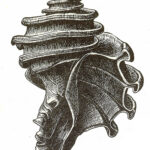Richard D. L. Fulton
Nearly all 50 states in the United States have designated one or more species of prehistoric life as a state fossil. Of the 47 states having done so, 3 state fossils are plants, while the remaining 44 states have prehistoric animals as their state fossils.
The State of Maryland opted to designate a fossil snail as the state fossil but ran into a couple of problematic issues along the way.
The state fossil of Maryland is a circa 19-million-year-old marine snail (gastropod) known as Ecphora, which is found in Maryland among the bayside cliffs that make up an assemblage of geologic formations designated as the Chesapeake Group.
There was, of course, no Chesapeake Bay when Ecphora existed, which was during a period of time referred to as the Miocene Epoch, when the Atlantic Ocean had made a major incursion into Maryland in the form of a large bay (referred to as the Salisbury Embayment). The shoreline of this bay, which stretched from west of Washington, D.C., and Baltimore, rejoined the main oceanic shoreline in the Philadelphia area.
Shell collectors might likely be familiar with the showy, modern murex shells of the subtropical and tropical seas. Ecphora was a prehistoric member of the murex family.
The Maryland General Assembly designated Ecphora as the state fossil in 1984, and then things got a little wacky from there.
First and foremost, the state chose Ecphora because it was claimed to have been the first fossil that had been collected in the New World and described by scientist Martin Lister in 1770.
Problem number one was, contrary to popular belief among the sciences at the time, Ecphora was not the first fossil described from the New World. That honor actually belonged to a species of Chesapecten (an extinct scallop) that shared the 19-million-year-old sea with Ecphora. Chesapecten was described by Lister in 1687, according to the Maryland Geological Survey.
Nevertheless, under somewhat false pretense, Ecphora remained as the state fossil until 1994, when problem number two reared its head. Someone realized (more likely a paleontologist, who studies ancient plant and animal life) that the state had the wrong species of Ecphora. It appears that the species of Ecphora the state named as the state fossil actually only occurred in Virginia.
To be honest, naming a Virginia species of Ecphora, rather than a Maryland species, cannot be blamed entirely on the state.
Since the original 1984 state fossil designation, research on the Ecphora became a little more complicated…and it all came down to species.
The species of Ecphora named as the state fossil in 1984 was a species known as Ecphora quadricostata, a species initially described in 1861. However, further research determined in 1987 that Ecphora quadricostata only occurred south of Maryland. The Maryland “Ecphora quadricostata” was then renamed Ecphora gardnerae in 1987.
To complicate matters further, it was subsequently determined in 1988 that the Maryland Ecphora gardnerae was slightly different than an actual Ecphora gardnerae, and a subspecies name was then added in order to reflect this, thereby resulting in the state fossil now being Ecphora gardnerae gardnerae.
Maryland finally “threw in the towel,” and, on October 1, 1994, the Maryland General Assembly redesignated the official state fossil of Maryland as Ecphora gardnerae gardnerae.
Anyone interested in obtaining a specimen of the state fossil from one of the fossil sites should take a day trip to the Western Shore of the Chesapeake. A list of potential fossil sites and collecting tips can be found at fossilguy.com (https://www.fossilguy.com/sites/calvert/index.htm).
Always make certain that the beach being accessed is not private property. Additionally, digging in the cliffs is prohibited anywhere along the Western Shore to prevent landslides.
A good starting point would be to visit the Calvert Cliffs State Park in Lusby. Fossil collecting along the beach is permitted. Directions and additional information can be found on the Maryland Department of Natural Resources website at dnr.maryland.gov.


